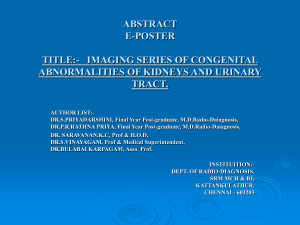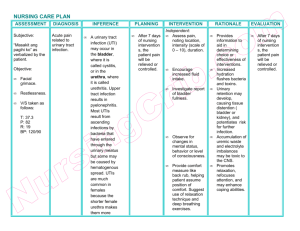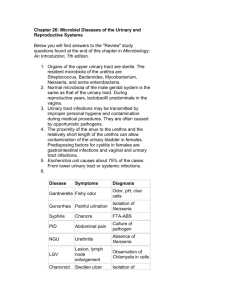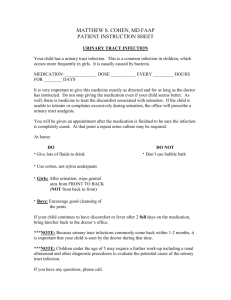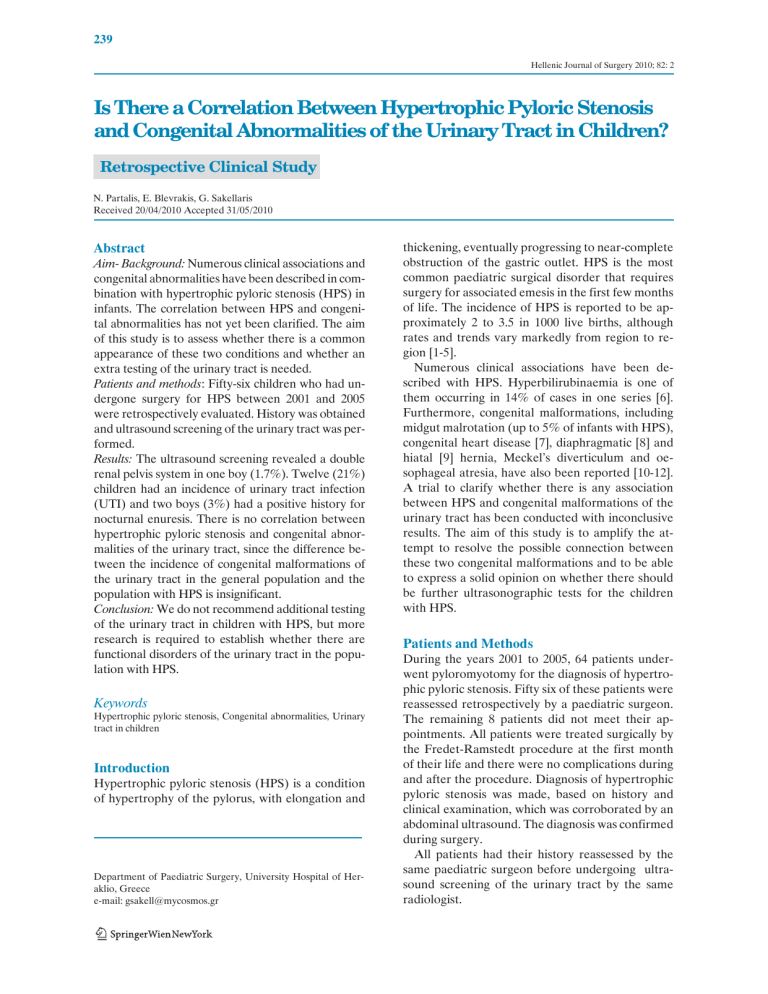
36 239 Hellenic Journal of Surgery 2010; 82: 2 Is There a Correlation Between Hypertrophic Pyloric Stenosis and Congenital Abnormalities of the Urinary Tract in Children? Retrospective Clinical Study N. Partalis, E. Blevrakis, G. Sakellaris Received 20/04/2010 Accepted 31/05/2010 Abstract Aim- Background: Numerous clinical associations and congenital abnormalities have been described in combination with hypertrophic pyloric stenosis (HPS) in infants. The correlation between HPS and congenital abnormalities has not yet been clarified. The aim of this study is to assess whether there is a common appearance of these two conditions and whether an extra testing of the urinary tract is needed. Patients and methods: Fifty-six children who had undergone surgery for HPS between 2001 and 2005 were retrospectively evaluated. History was obtained and ultrasound screening of the urinary tract was performed. Results: The ultrasound screening revealed a double renal pelvis system in one boy (1.7%). Twelve (21%) children had an incidence of urinary tract infection (UTI) and two boys (3%) had a positive history for nocturnal enuresis. There is no correlation between hypertrophic pyloric stenosis and congenital abnormalities of the urinary tract, since the difference between the incidence of congenital malformations of the urinary tract in the general population and the population with HPS is insignificant. Conclusion: We do not recommend additional testing of the urinary tract in children with HPS, but more research is required to establish whether there are functional disorders of the urinary tract in the population with HPS. Keywords Hypertrophic pyloric stenosis, Congenital abnormalities, Urinary tract in children Introduction Hypertrophic pyloric stenosis (HPS) is a condition of hypertrophy of the pylorus, with elongation and Department of Paediatric Surgery, University Hospital of Heraklio, Greece e-mail: gsakell@mycosmos.gr thickening, eventually progressing to near-complete obstruction of the gastric outlet. HPS is the most common paediatric surgical disorder that requires surgery for associated emesis in the first few months of life. The incidence of HPS is reported to be approximately 2 to 3.5 in 1000 live births, although rates and trends vary markedly from region to region [1-5]. Numerous clinical associations have been described with HPS. Hyperbilirubinaemia is one of them occurring in 14% of cases in one series [6]. Furthermore, congenital malformations, including midgut malrotation (up to 5% of infants with HPS), congenital heart disease [7], diaphragmatic [8] and hiatal [9] hernia, Meckel’s diverticulum and oesophageal atresia, have also been reported [10-12]. A trial to clarify whether there is any association between HPS and congenital malformations of the urinary tract has been conducted with inconclusive results. The aim of this study is to amplify the attempt to resolve the possible connection between these two congenital malformations and to be able to express a solid opinion on whether there should be further ultrasonographic tests for the children with HPS. Patients and Methods During the years 2001 to 2005, 64 patients underwent pyloromyotomy for the diagnosis of hypertrophic pyloric stenosis. Fifty six of these patients were reassessed retrospectively by a paediatric surgeon. The remaining 8 patients did not meet their appointments. All patients were treated surgically by the Fredet-Ramstedt procedure at the first month of their life and there were no complications during and after the procedure. Diagnosis of hypertrophic pyloric stenosis was made, based on history and clinical examination, which was corroborated by an abdominal ultrasound. The diagnosis was confirmed during surgery. All patients had their history reassessed by the same paediatric surgeon before undergoing ultrasound screening of the urinary tract by the same radiologist. 240 Hellenic Journal of Surgery 2010; 82: 2 Results Of the 56 infants and children with hypertrophic pyloric stenosis who were assessed by ultrasound screening of the urinary tract, 45 were boys and 11 were girls with a male to female ratio of 4.1:1. The age varied from 21 days to 8 years with a mean of 5 years. Out of the 56 children and infants, 12 (21%) had a previous incidence of urinary tract infection (UTI), 10 of whom were boys and 2 were girls. Two boys (3%) had (under the age of four) a positive history for nocturnal enuresis. No family history of HPS was reported and there was no coexisting disease, either congenital or acquired. On clinical examination, none of the children were found to have a developmental or functional problem with the urogenital system. Ultrasound screening of the urinary tract revealed the existence of a right double renal pelvis in a boy (1.7%), who also had a UTI. It did not reveal any problems at the shape or the matrix of the kidney, the ureters, the urinary bladder or the urethra in any of the other children. Discussion Hypertrophic pyloric stenosis is a condition that causes severe vomiting in the first weeks of life. There is narrowing of the pylorus due to the enlargement of the pyloric muscle, which spasms when the stomach empties. It is uncertain whether there is a real congenital narrowing or a functional hypertrophy of the muscle which develops in the first weeks of life. However, it is probable that there is a genetic predisposition for the development of HPS [13]. Numerous clinical associations with HPS in infants have been described. Hyperbilirubinaemia is the most frequent clinical association occurring in 14 percent of cases in one series [6]. HPS has also been correlated with midgut malrotation [14], joint hypermobility [15,16], congenital heart disease [7], congenital hypothyroidism [17],hernias [8,9] and other congenital diseases. An association between congenital anomalies of the urinary tract and HPS has been suggested by a few case reports, amongst which one case of hydronephrosis [18], one of nephrotic syndrome [19] and another of newborn twins and their father with polycystic kidney disease [20] were found to have HPS. Apart from these reports, several studies have examined series of infants with HPS to determine a potential relation with congenital uropathies. In 1981, Atwell et al [21], studied two series and found an abnormality of the urinary tract, either major or minor, in 20.6% of the infants in the first series and 2.7% in the other. The percentage of these abnor- Is There a Correlation Between Hypertrophic Pyloric Stenosis and Congenital Abnormalities of the Urinary Tract in Children? malities was 4%, as recorded by Fernbach et al. in 1993 [22], 1.4% by Bidair et al. in 1993 [23] and 1% by Moshe Nussinovitch et al. in 1998 [24]. Similarly, the percentage of the urinary abnormalities was not high in the series of Applegate Ms in 1995 and of S. Cascio (4%) in 2005 [25]. In our series, the percentage of major urinary malformations was 1.7% (one boy) and of minor malformations 0%, which could be explained by the small population of our study. Routine ultrasound screening of the urinary tract in the neonatal population shows an incidence of 1–2% for major anomalies and up to 5% for minor anomalies [26, t27]. Since there is no significant difference in incidence of either major or minor abnormalities of the urinary tract in the general population, with the exception of the small series of Atwell [21], it may be safe to assume that these two entities do not have a connection between their congenital causes. Renal ultrasonography is the test of choice to exclude urinary tract abnormalities, thereby avoiding the potential allergic and toxic complications of radiocontrast media and avoiding an invasive approach. The specificity and sensitivity is not as good as in other radiographic tests but since no abnormalities of the urinary tract were found, no further testing was done. The incidence of urinary tract infection in our study was 21%. Moshe Nussinovitch et al [24] found a prevalence of 2.8% of UTI in infants with HPS, which was 20 times higher than the general population [23]. The overall prevalence of UTI is approximately 7% in febrile infants and young children [2830]. The high incidence in our series suggests that there is an association between HPS and UTI, warranting further thorough research. Only one of the children with UTI had a positive ultrasonographic examination, which could lead to a functioning disorder of the urinary system, such as vesicoureteral reflux. However, more examinations must be done in order to exclude false negative results from the ultrasound scan, such as urodynamics and magnetic resinance imaging (MRI). Conclusion Since there is no significant difference between the incidence of congenital malformations of the urinary tract in the general or the healthy population and the population with HPS, it would appear that there is no correlation between hypertrophic pyloric stenosis and congenital abnormalities of the urinary tract. Our Department does not recommend additional testing of the urinary tract in children with HPS to the already existing screening test. Further 37
